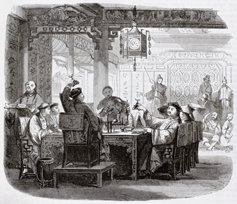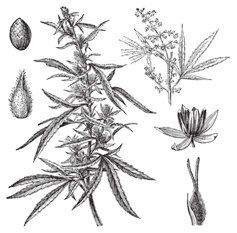History of Marijuana
ON THIS PAGE
Early Marijuana Use

Marijuana has been used as medicine and a way of achieving euphoria since ancient times. The first reference to its use is in a Chinese medical manual dating back to around 2700 B.C. Chinese legend states that its usefulness in treating rheumatism, gout, malaria and, oddly enough, absent-mindedness was documented by Chinese Emperor Shen Nung — known as the Father of Chinese Medicine.
Its use spread from China to Korea, India and then to Eastern Africa. In India, the plant was celebrated in one of the Sanskrit Vedic hymns as an herb that could “release us from anxiety.” Ancient doctors prescribed marijuana for pain relief but also advised against using it too much as it could cause the user to “see devils.”
An Egyptian papyrus from about 1500 B.C. makes mention of cannabis as a useful way to treat inflammation.
In the Arab world, references to hashish began to show up between 800 A.D. and 1000 A.D. The plant’s intoxicating effects began to be emphasized around this time. Muslims used marijuana recreationally since alcohol consumption was banned by the Koran but marijuana was not. Hindus in India revered the use of marijuana in a mildly intoxicating drink called bhang, saying that it cured a long list of ills, including problems with sunstroke, digestion and dysentery.
Marijuana in America

In the mid-1500s, the Spanish brought cannabis to the New World. They intended to grow this crop for hemp — strong fibers that could be used for clothes, bags and most especially for the rigging of ships. In Britain as well as Scandinavia, cannabis was an important crop because hemp ropes were durable despite wet, salty environments. More than 120,000 pounds of hemp ropes made from the fibers of cannabis plants were required to complete the rigging for the U.S.S. Constitution.
Also in the mid-1500s, African slaves transported to Brazil brought cannabis with them. They worked farms in Brazil and they were allowed to grow crops of marijuana to smoke.
When steamships began to replace sailing ships in the late 1800s, the need for hemp began to wane.
By 1890, hemp had been replaced by cotton as a major cash crop in southern U.S. states, but hemp plants were not grown for their intoxicating properties. The level of intoxicant in this plant was very low. That began to change in 1910 when many people fled Mexico during that country’s revolution, arriving in America and bringing cannabis with them.
Cannabis appeared as an ingredient in many patent medicines of the day, but it was a small percentage compared to the number containing opium or cocaine.
Soon after 1910, European and American legislators began to ban the use of drugs. First, there was an Opium Convention in 1912 and the Harrison Act of 1914 that, for the first time, defined use of cannabis and other drugs as a crime. By 1925, cannabis was banned or restricted in thirteen countries, including the United States. For some reason, this law did not go into effect until 1938.
It was in the 1920s that marijuana began to catch on. Some historians say its emergence was brought about by Prohibition. Its recreational use was largely restricted to jazz musicians and people in show business. “Reefer songs” became the rage of the jazz world. Marijuana clubs called tea pads sprang up in every major city. These marijuana establishments were tolerated by the authorities because marijuana was not illegal and patrons showed no evidence of making a nuisance of themselves or disturbing the community. Marijuana was not considered a social threat.
Marijuana was listed in the United States Pharmacopeia from 1850 until 1941 and was prescribed for various conditions including labor pains, nausea, and rheumatism. Its use as an intoxicant was also commonplace from the 1850s to the 1930s.
A campaign conducted in the 1930s by the U.S. Federal Bureau of Narcotics (now the Bureau of Narcotics and Dangerous Drugs) sought to portray marijuana as a powerful addictive substance that would cause some users to become violent.
By the 1950s, it was an accessory of the beat generation. In the 1960s it was used by college students and “hippies” and became a symbol of rebellion against authority.
The Controlled Substances Act of 1970 classified marijuana along with heroin and LSD as a Schedule I drug, which means that it has high abuse potential and no accepted medical use. Colombia then became the main supplier.
The “zero tolerance” climate of the Reagan and Bush administrations resulted in passage of strict laws and mandatory sentences for possession of marijuana and in heightened vigilance against smuggling at the southern borders. The “war on drugs” thus brought with it a shift from reliance on imported supplies to domestic cultivation (particularly in Hawaii and California) but still, boatloads of high-potency marijuana made their way from Colombia to the U.S.
Beginning in 1982, the Drug Enforcement Administration turned increased attention to marijuana farms in the United States. The potency of domestic marijuana was also increasing at this time, doubling between 1979 and 1985. According to the Monitoring the Future annual survey of drug use by teens, more than a decade of decline in marijuana use reversed in 1992. Use increased until 1997 and since then, has gone through small increases and decreases. It has never returned to the low level seen in 1991.

Every year, marijuana becomes more pervasive in the world. Download this booklet to get the facts.
DOWNLOAD NOW